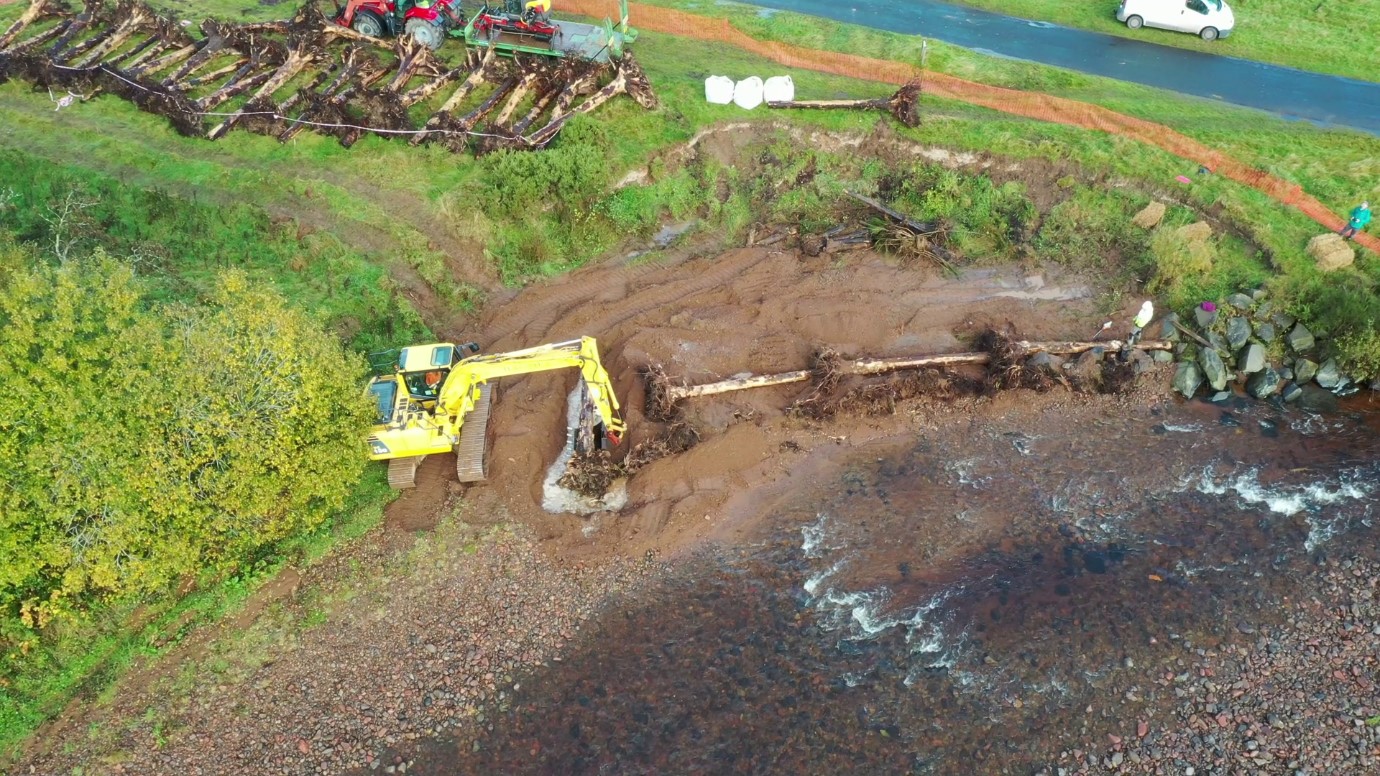The Till and Tweed Catchment Partnership
- Catchment HostTweed Forum Limited
- River Basin DistrictSolway Tweed
- Management CatchmentTill
- Management Catchment ID3100
Catchment partnership vision
The Till and Tweed Catchment Partnership work in both the Till and the Tweed management catchments and is hosted and facilitated by the Tweed Forum. Tweed Forum was formed in 1991 to promote the sustainable use of the whole of the Tweed catchment through holistic and integrated management and planning. In close partnership with our members, Tweed Forum staff work to protect, enhance and restore the rich natural, built and cultural heritage of the River Tweed and its tributaries. The Forum works at both the strategic level and the project level in order to achieve tangible benefits on the ground. From our inception as an informal liaison group, we have grown to become a leader in the field of integrated land and water management.

Related websites
Find out more about the activities and ambitions of this catchment partnership and how you can get involved to help improve the water environment in the catchment.
Catchment challenges
Current challenges identified by partnership

Physical modifications
Agricultural flood embankments have disconnected river from floodplain; fish passage is restricted by barriers

Pollution from agriculture and rural areas
Diffuse pollution from agriculture is impacting water quality in rivers and Fell Sandstone aquifer

Invasive Non-native Species
Highest impact INNS are American Signal Crayfish, Himalayan Balsam, Giant Hogweed and Japanese Knotweed
Wider water environment challenges identified by partnership
Nature Recovery, protect and enhance rare habitats including chalk streams
None of the SSSI units are in favourable condition due to lack of river habitat and invasive non-native species pressure
Support Nature Recovery Network and Local Nature Recovery Strategy
The LNRS will help to tackle biodiversity loss and impacts of climate change, with a more nature-friendly, strategic, and joined-up approach
Reduce storm overflows and drainage system incidents
Discharges from storm overflows impact water quality, actions to improve the condition of our waterbodies for people and wildlife is needed
Protect and restore healthy soils and nutrient balance
The Till catchment economy is linked to agricultural health, soils are at its heart and must be protected for future generations as climate changes
Build environmental resilience and adaptation to climate change
Climate change will increase pressure from flooding, drought and river temperature (e.g. causing thermal stress to fish)
Connecting communities with nature
The resilience of rivers, habitats and communities benefit from better integration with our local natural heritage
Future challenges predicted by partnership

Pollution from agriculture and rural areas
Drought and flooding events will become more frequent under current climate change predictions, this will, in turn, increase pollution from agriculture and rural areas

Changes to the natural flow and water levels
Extreme weather events are predicted to increase with climate change, both drought and flooding can negatively affect natural flows and water levels

Invasive Non-native Species
The impact of climate change and rising average temperatures will accelerate the expansion of INNS, each year 12-15 new non-native species are found in the UK
Future challenges predicted by Environment Agency
Future challenges in 2050
- Invasive Non-native Species
- Changes to the Natural Flow and Water Levels
- Pollution from agriculture and rural areas
Emerging challenges
- Changes to the Natural Flow and Water Levels
- Pollution from Agriculture and Rural Areas
- Physical modifications
Partnership success highlights 2016 to 2021
Tweed Forum is at the heart of land and water management in the cross border Tweed catchment (including the Till sub catchment) and has continued to deliver key outcomes for the catchment over the period 2016-2021. Our programme of environmental improvements has planted 738,447 trees, created 52 ponds and wetlands (covering over 5 ha), carried out 38 km of ditch blocking and hagg reprofiling (peat land restoration measures), installed 116 km of stock exclusion fencing, eased fish passage by removing Lilburn Weir (opening up 8 km of upstream habitat), emplaced 150 m of green bank protection, carried out 750 m of embankment removal, remeandered 830 m of watercourse, installed 110 log jams, secured 3566 ha of land for conservation management, actively controlled INNS on 300 km of watercourse throughout the Tweed catchment and engaged with 13,170 people.

Partnership development plans
Tweed Forum will continue to deliver integrated catchment management for the cross-border Tweed with particular focus on exploring novel funding mechanisms; updating the Tweed Catchment Management Plan and associated processes; continuing to deliver the Till River Restoration Strategy; developing the ambitious source-to-sea, multi-million Destination Tweed initiative; refining our methodologies for targeted measure delivery - ensuring the right measure in the right place at the right scale.
Partnership priority actions and measures for 2022 to 2027
Confident
Haugh Head ford removal – easement of fish passage and reconnecting the Wooler Water with floodplain, £1 million+
- Reason for measure
- Mitigate the impacts on ecology from physical modifications in modified waters
- Delivery mechanism
- EA Flood/coastal risk management programme
- Location
- Wooler Water from Harthope Burn to Till
Confident
River Glen - removal/set-back of extensive flood embankments to dissipate flood energy, £400k
- Reason for measure
- Mitigate the impacts on ecology from physical modifications in modified waters
- Delivery mechanism
- EU funding
- Location
- Glen from College Burn to Till
Less certain
Till from Linhope Burn to Roddam Burn - restore modified waterbody and introduce riparian vegetation
- Reason for measure
- Mitigate the impacts on ecology from physical modifications in modified waters
- Delivery mechanism
- EA Flood/coastal risk management programme
- Barriers to delivery
- Improved flexibility and coordination between agri-environment schemes and capital funding
- Location
- Till from Linhope Burn to Roddam Burn
Less certain
Till Source to Linhope Burn - introduce riparian vegetation for shade and morphological diversity in reach
- Reason for measure
- Manage modified habitats
- Delivery mechanism
- None identified
- Barriers to delivery
- Improved flexibility and coordination between agri-environment schemes and capital funding
- Location
- Till from Source to Linhope Burn
Less certain
Reconnecting the Wooler Water
- Reason for measure
- Mitigate the impacts on ecology from physical modifications in modified waters
- Delivery mechanism
- Other Public funding
- Barriers to delivery
- Funding and permissions
- Location
- Wooler Water from Harthope Burn to Till
Wider water environment
Life WADER is a 5 year project beginning in 2021 that will address water quality and invasive non-native species pressure
- Reason for measure
- Nature Recovery, designated areas for nature and biodiversity
- Delivery mechanism
- EU funding
- Location
- Tweed
Wider water environment
Destination Tweed aims to celebrate, promote and conserve the natural, built and cultural assets of the River Tweed
- Reason for measure
- Connecting communities with nature
- Delivery mechanism
- Other Public funding
- Location
- Tweed
Wider water environment
The Till River Restoration Strategy works to improve the morphology of the River Till Site of Special Scientific Interest (SSSI)
- Reason for measure
- Nature Recovery, designated areas for nature and biodiversity
- Delivery mechanism
- EA Flood/coastal risk management programme
- Location
- Till River
Catchment Partnership contributors
Partners involved in the creation of this page and the actions of the partnership:
- Royal Society for the Protection of Birds
- Scottish Water
- Scottish Wildlife Trust
- Northumberland County Council
- Tweed Forum
- Northumberland Wildlife Tust
- Scottish Forestry
- NatureScot
- Tweed Foundation
- Southern Uplands Partnership
- National Farmers Union Scotland
- Borders Forest Trust
- Scottish Land and Estates
- Natural England
- Northumberland National Park
- Scottish Environment Protection Agency
- Scotland's Rural College
- Scottish Government
- Federation of Borders Angling Association
- Visit Scotland - Scottish Borders
- Scottish Borders Council
- River Tweed Commission
- Northumbrian Water
- Environment Agency